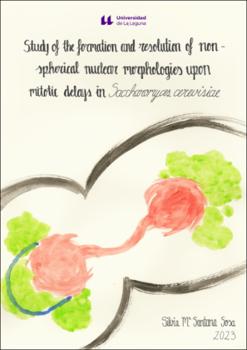Study of the formation and resolution of non-spherical nuclear morphologies upon mitotic delays in Saccharomyces cerevisiae
Author
Santana Sosa, Silvia MaríaDate
2023Abstract
The morphology of the nucleus is mostly spherical in many organisms across eukaryotes. However, this organelle needs to adapt when the cell is subjected to challenging physiological conditions, such as cell migration in higher eukaryotes, to travel through the narrow intercellular spaces, or cell division in organisms which perform closed mitosis (i.e. without dismantling the nuclear envelope), like yeast, to transform a single nucleus into the two daughter nuclei in mitosis. In addition, the nuclear morphology can be modified in pathological conditions too, being a hallmark of cancer cells. Strikingly, recent evidence in cell lines have linked aberrant nuclear morphology with defects in lysosomal function, related to the recycling process called autophagy, and with genome instability too. These data evidence a close relationship between nuclear morphology and function. Thus, understanding nuclear morphology dynamism and stability is of uttermost importance, as pathways and proteins involved in nuclear shaping may be key to develop targeted anticancer and antifungal drugs.
Previously, our group and others have described, using the budding yeast Saccharomyces cerevisiae as model, that in a metaphase (mid-M) block triggered by microtubule depletion the nucleus and the nucleolus drastically change their shape. The spherical morphology is lost in favor of the appearance of a single finger-like projection which can bend to the point of forming a handle or loop. Furthermore, this projection affects the nucleolar domain, which allocates the ribosomal DNA (rDNA), ribosomal RNAs (rRNAs), the rRNA processing machinery, as well as ribosomal proteins and ribosome assembly factors.
In this work, using the yeast model and fluorescence microscopy, we have observed that the rDNA loop in a mid-M block makes the nucleus resemble a toroid, as the ones recently and independently observed in higher eukaryotes, with the space under the rDNA loop occupied by the vacuole, which is the equivalent of the human lysosome. Besides, the establishment of this configuration depends on factors such as phospholipid synthesis and the absence of microtubules, as it does not form in the mid-M block caused by other mid-M blocks that preserve microtubules. Furthermore, we studied how these non-canonical nuclear morphologies evolve once cells are released from the mid-M blocks, which appear to eventually recover a rounded shape by telophase, without apparently having a negative impact on genome stability. Interestingly, there seems to be an increase in autophagy levels, which may be triggered to recycle the excess of nuclear membrane accumulated during the mitotic block.





